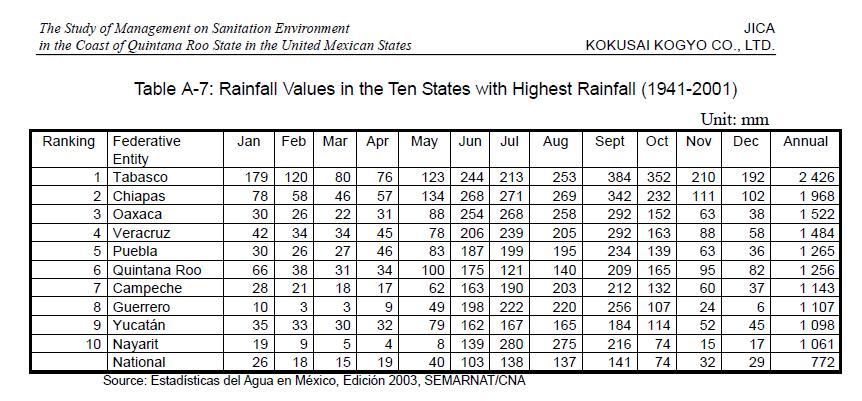Project Description
Objective
The objective of this project is to investigate the feasibility of constructing, installing, utilizing and maintaining a micro hydro system to provide electricity for a rural community near San Cristóbal de Las Casas, Chiapas, Mexico. The feasibility tests will include studies on potential power available from several rivers and a survey of the available building materials and operation costs. If the results of the feasibility are positive the design and implementation of this project will be completed by another party.
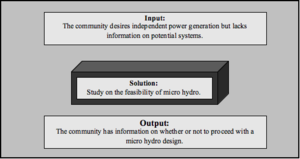
Background
There are many river systems in Chiapas and near San Cristóbal de Las Casas as well as many communities without reliable electricity. To provide an efficient compliment to existing energy sources or to completely supplement energy for a community could potentially be of great use and improve the standard of living. In addition, there are many sources of energy in Chiapas that are harmful to the environment of river systems. Río Grijalva, one of the largest rivers in Chiapas, has many dams that have caused flooding of communities in the past and potentially impede or harm the lives of aquatic animals. A micro hydro system, if designed and constructed properly, would greatly reduce the environmental impact while providing an efficient energy source. However, recently some communities in Chiapas have begun protesting and even boycotting government provided energy due to high tax rates. This seems to imply interest of some communities to examine alternative methods for obtaining energy, micro hydro being one of those.
Literature Review
What is Micro Hydro?
Most simply, micro hydro systems utilize the power of water to turn a turbine that converts water pressure into mechanical motion that can then be used to directly power the shaft of machinery, or the turbine could run an electric generator to create AC power. Micro hydro can be used to power to remote communities or provide a renewable power resource to existing electric grids.
Here is a short video about the basics of how Micro Hydro Electric Power works. This is just one example of a Micro Hydro system. There are many variations and designs they can take on depending on the conditions of your site.
- Micro-Hydropower Systems: A Buyer's Guide by Natural Resources Canada.
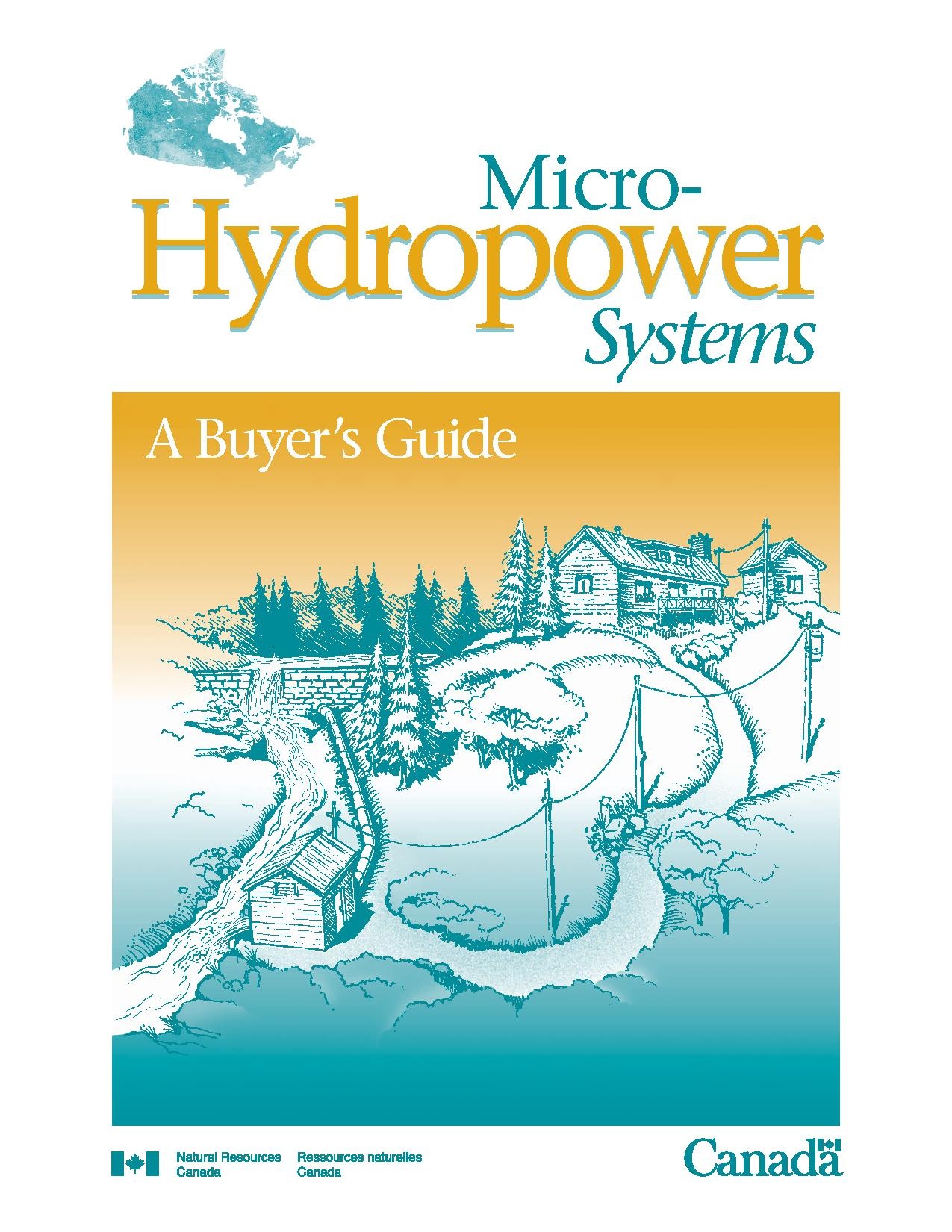
- A handbook from Natural Resources Canada providing a complete description of what micro hydro is, conducting a feasibility study, determining energy demand, components of a micro hydro system, and approximate costs of materials.
Components of Micro Hydro System
- Microhydro: Clean Power From Water by Scott Davis
- This book contains descriptions and graphics of the components of a micro hydro system including the intake screen, forebay tank, penstock and powerhouse.
- Micro-Hydropower Systems: A Buyer's Guide by Natural Resources Canada.

- This handbook contains descriptions of the function of each component in the system.
Intake
Here is a short video of a Micro Hydro system beginning with the intake and ending at the waterwheel. The first image is of a submerged intake.
- Here is a comprehensive list of Micro Hydro intake designs covering different methods of diverting water broken down by best application, benefits, drawbacks and average cost
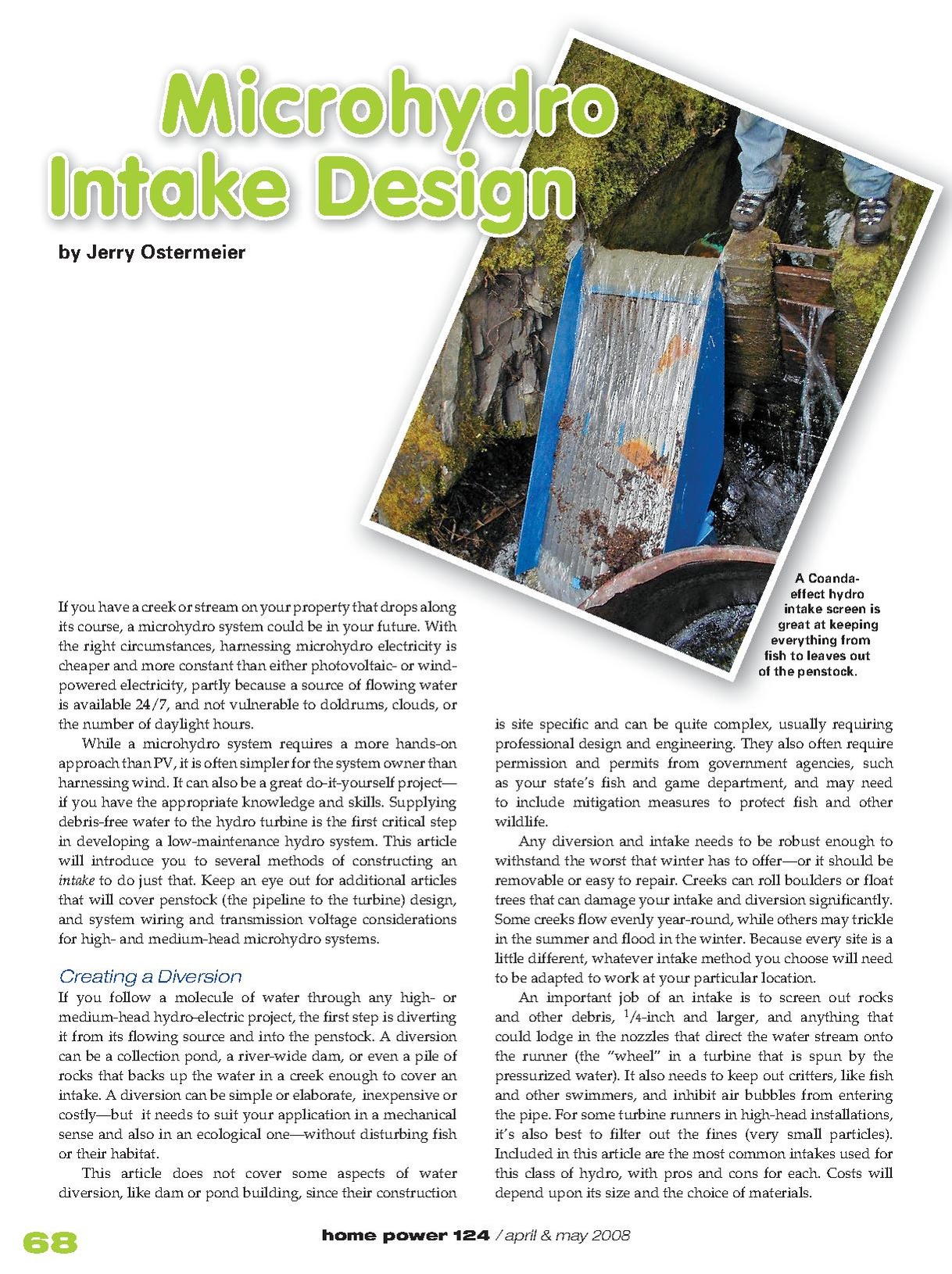 .
.
Settling (Forebay) Tank
Connects the intake channel and penstock. Settles sediment and and small debris to keep it from clogging the penstock and turbine parts.
Penstock
The penstock pipe transfers water to the turbine where the pressure created by the head turns the turbine. The penstock must be designed specifically to the site's river flow and head pressure conditions for optimal performance. Water running through a pipe encounters friction that slows its flow rate, essentially reducing the amount of head pressure the water has to produce power.
- PDF File: http://www.builditsolar.com/Projects/Hydro/WaterTurbineAppendix.pdf
- Page 27 has Pressure Friction Head Loss table (based on Schedule 40 PVC) and page 28 has a Friction Head Loss of Fittings table.
Turbine Types
- Micro Hydro Power Design Booklet by Jim Norman http://www.scribd.com/doc/31432159/Micro-Hydro-Power-Design-Booklet
- Defines the functions of and differences between impulse and reaction turbines as well as the right conditions for each one. Also gives specifications for 9 brands of turbines.
- Appendix 6 has an equation and table to assist in choosing the right turbine after finding the head flow and electricity requirements.
- http://www.hydro-turbines.com/id74.html
- Descriptions of various turbine types and explanations of appropriate situations for each turbine.
- Here is a rating of effectiveness of Impulse Turbine types based on the amount of Flow and the amount of Head borrowed from the Microhydro Appropedia page Microhydro.
| Turbine Type | Flow | Head |
| W | Lowest | Highest >10ft |
| W | Intermediate | Intermediate >4ft |
| W | Highest | Lowest <4ft |
Tail Race
- File: http://www.builditsolar.com/Projects/Hydro/WaterTurbineAppendix.pdf
- The tail race must be designed such that the flow of water returning to the river does not cause too much erosion. Page 35 provides a list of velocities of water that will reduce the amount of erosion based on the type of soil. Page 36 has a table of Water Flow Through Various Nozzle Diameters based on head and pressure to assist in the design of the tail race.
Electrical Components
- Homepower Magazine Microhydro Electriciy Basics provides a basic overview of different Micro Hydro Electric System Types and a list of necessary components.
Transmission Lines
In an AC Direct system, there must be wires to carry the electricity to the community. An ideal system is placed near a community so the electricity loss is minimized in transfer.
- http://www.builditsolar.com/Projects/Hydro/WaterTurbineAppendix.pdf
- Page 43 has Wire Size versus Voltage drop table and an equation for calculating the voltage drop.
System Types
- Homepower Magazine Micro Hydro Electricity Basics provides a basic overview of different Micro Hydro Electric System Types and a list of necessary components
Battery Based
A battery based system is used for a micro hydro system that cannot create enough electricity for the highest load requirement of the day. Storing the energy created overnight in batteries helps to meet peak energy need midday. Battery systems can also be used for communities that only need lighting and appliance power. Available power is limited by the size of the inverter.
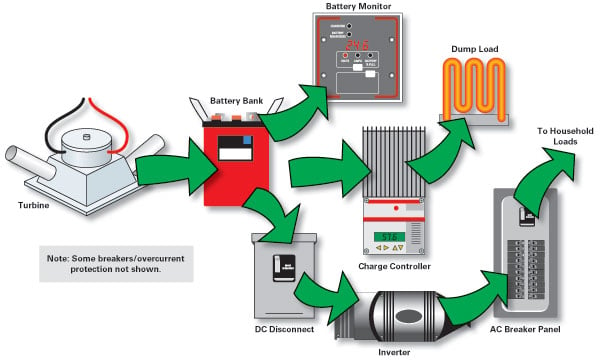
Electrical components of a Battery Based System from Homepower Magazine Micro Hydro Electricity Basics
AC Direct
AC integrated systems bring the generated electricity directly to a user. Available power is limited by the potential of the stream, so if the site has enough flow and head this system can be designed to the highest load requirement of the community.
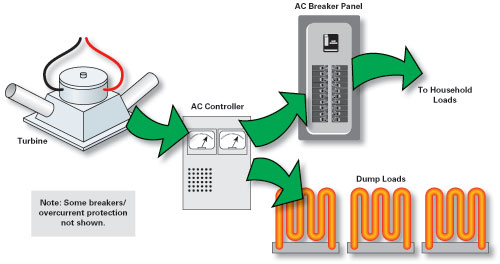
Electrical components of a AC Direct System from Homepower Magazine Micro Hydro Electricity Basics
Pros and Cons
- Small Hydro Power: Technology and Current Status. Renewable and Sustainable Energy Reviews. Volume 6, Issue 6, December 2002, Pages 537-556
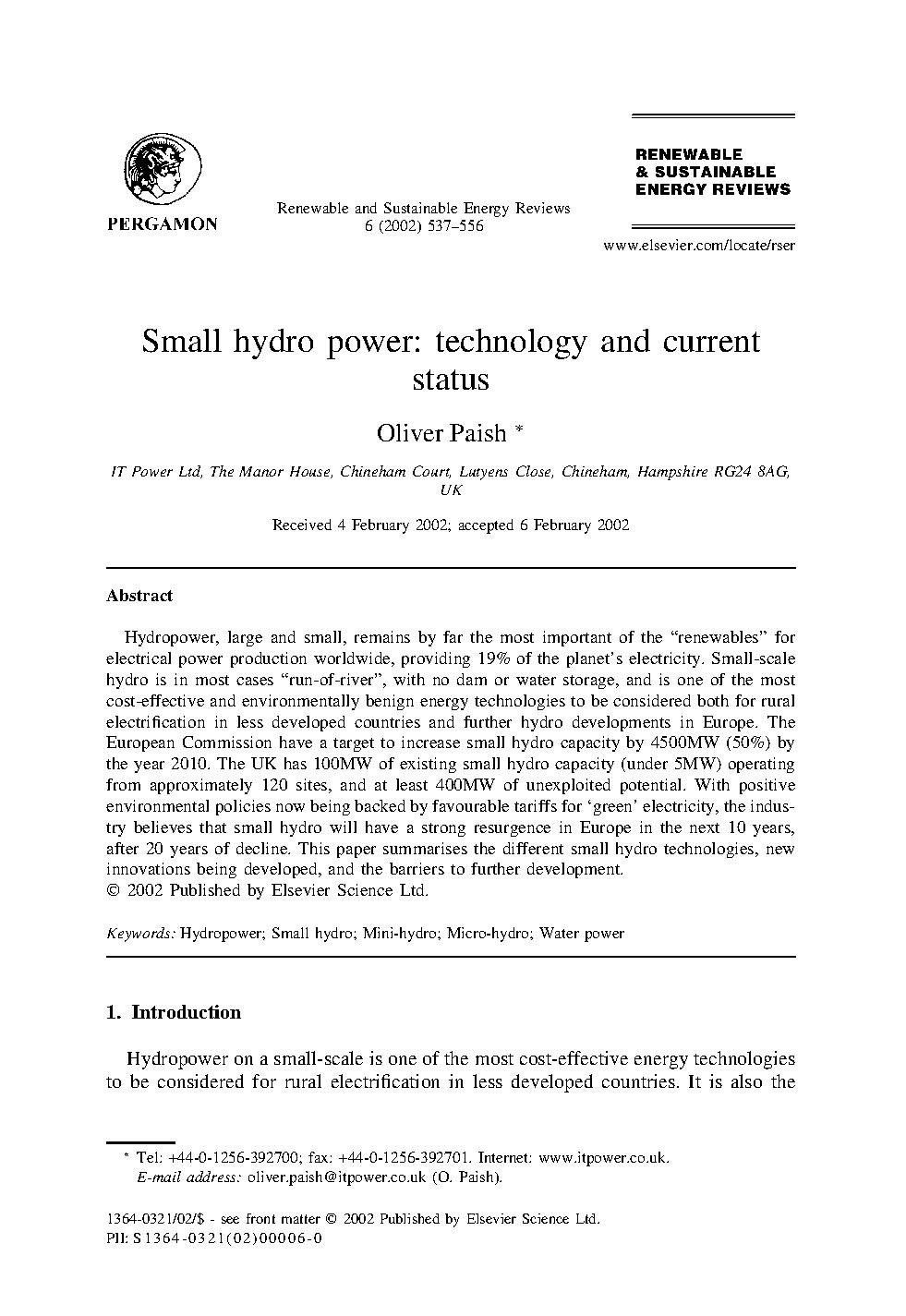
- The conclusion provides a list of pros and cons. The pros include: water is a concentrated and continuous source of energy, energy availability is fairly predictable, very little maintenance is required and there is very little environmental impact. The cons include: good sites close to communities are hard to find, there is not much room for expanding the power created, variations in seasonal river flow can limit power availability, and other uses for the water, such as irrigation, can take away from the usability of the system.
- The Citizen-Powered Energy Handbook: Community Solutions to a Global Crisis by Greg Pahl
- Pahl describes the cons of a micro hydro system such as the lack of government support and subsidies. Also, the additional work and maintenance which may be undesirable if the electricity recipients are already grid tied.
- Overview of Micro Hydro from the Ashden Awards for Sustainable Energy
- Micro hydro systems can bring power to a community enabling them to increase their quality of life and economic activity. Greenhouse gases are reduced because less fossil fuels are used, and the overall system has little environmental impact because the water is returned to the river.
- Micro Hydro Power Pros and Cons from Alternative Energy News
- List of advantages and disadvantages similar to the Small Hydro Power: Technology and Current Status article. Disproved myths about using micro hydro power such as hydro power will damage the ecosystem, the electricity is unreliable and of low quality, and that hydro power is free.
- Checklist on Small Hydro Power by European Small Hydro Power Association
- Checklist provided by MHyLab, SCPTH and ESHA for pre-feasibility of micro hydro on determining energy, environmental and economic feasibility for developing a small hydro installation.
Feasibility Study
The feasibility of a micro hydro system is firstly dependent upon the flow and head available at the site, and secondly, the electricity load and proximity of the system to the community.
Data Collection Methods
- Micro-Hydropower Systems: A Buyer's Guide by Natural Resources Canada.

- Section 2.5 describes the types of questions to answer in a feasibility study including:
- How much head is available?
- What are the maximum and minimum flow rates?
- How long does the penstock have to be?
- How much power can be generated at the flow rates?
- Initial and annual costs?
- Potential environmental effects of installing micro hydro?
- Appendix B has a form to fill out based on the site's stream info and electrical needs.
- Section 2.5 describes the types of questions to answer in a feasibility study including:
- Micro Hydro Power Design Booklet by Jim Norman
- Appendix 2 describes how to measure head and how to find a flow rate based on finding the speed of the water and cross sectional area of the river as well as the bucket method.
- Appendix 3 has a Load Evaluation Form to determine the amount of power output needed from your system to meet the needs of the community.
- The Homeowner's Guide to Renewable Energy: Achieving Energy Independence by Daniel D. Chiras
- Describes an effective way to measure head using a carpenter´s level and calibrated pole.
- Appropedia - How to Measure Stream Flow Rate
- Appropedia page with concise and simple descriptions of several ways to measure stream flow rate.
Power Output Equation
- Here is the equation to determine the energy output of a Micro Hydro system based on Flow Rate, Head, and Gravity of the water source borrowed from the Microhydro Appropedia page Appropedia Microhydro.
The amount of energy released by lowering an object of mass by a height in a gravitational field is[1]:
- where is the acceleration due to gravity.
Converting these units, a common field equation to measure the maximum power available in a moving body of water is:
Where:
- Pmax=Maximum Power Available (kW)
- Qmax=Flow (Volume/time)
- Hmax=Head (Vertical drop in ft)
- emax=Efficiency of the turbine (use a value of 1 for max power available)
- K=Unit conversion factor (see table below for some common values)
| For Q measured in | K is equal to |
| ft3/min | 708 (ft4)/(min*kW) |
| ft3/sec (CFS) | 11.8 (ft4)/(sec*kW) |
| l/sec | 102 (l*ft)/(sec*kW) |
| gal/min (GPM) | 5302 (gal*ft)/(min*kW) |
To find the actual power you will get from that moving body of water, calculate Pnet with the following changes made.
Where:
- Pnet=The net power extracted from the river, not including loss in delivery from power station to load (kW)
- Qnet=Flow (Volume/time) - Only take a portion of the max flow (%take). For delicate streams this may be a small percentage of the total flow.
- Qnet=Qmax*%take
- Hnet=Head (Vertical drop in ft) - This is the actual head that you have available due to losses from friction. Calculate friction loss using tables based on the materials you use for diversion (e.g. PVC).
- Determine equivalent length of pipe by adding actual length of pipe and equivalent lengths of fittings based on tables using pipe size.
- Find Frictional Pressure Loss Ratio (FPL) coefficient in ftloss/ftpipe based upon flow rate and pipe size
- calculate Hloss=equivalent length of pipe * FPL
Hnet=Hmax-Hloss
- enet=Efficiency of the turbine - Always between 0 and 1, usually between .5 and .9 depending on the turbine type and flow rate. A value of 0.78 is a good guess for modern turbines in average conditions.
- K=Unit conversion factor (see table above for some common values)
Note that these equations are static in time. You must run these equations for with a resolution high enough to cover periods of variation (e.g. monthly river data).
Conversion Factors
- Micro Hydro Power Design Booklet by Jim Norman
- Appendix 11 has formula and conversion factors useful in sizing a hydro system.
- File: http://www.builditsolar.com/Projects/Hydro/WaterTurbineAppendix.pdf
- Page 24 has important water power formulas for things such as horsepower, efficienct and cubic feet per second. Page 38 and 44 have electrical formulas and 39-40 have key conversion factors.
Cost
The cost of a system is dependent on the location, power needs, locally available materials or components, and type of system you build.
Materials
Information pending further investigation of local material availability and actual project design which can change quantities.
| Battery Based System Materials | Quantity | Cost |
| Intake Construction Materials | ? | |
| PVC Pipe | ? | |
| PVC Pipe Fittings | ? | |
| Turbine/Generator | ? | |
| Inverter | ? | |
| Dump Load Controller | ? | |
| Batteries | ? | |
| Battery Monitor | ? | |
| Transmission Line Wire | ? | |
| Controller | ? | |
| Powerhouse Construction Materials | ? | |
| Permits | ? |
| AC Direct Materials | Quantity | Cost |
| Intake Construction Materials | ? | |
| PVC Pipe | ? | |
| PVC Pipe Fittings | ? | |
| Turbine/Generator | ? | |
| Dump Load Controller | ? | |
| Transmission Line Wire | ? | |
| Controller | ? | |
| Powerhouse Construction Materials | ? | |
| Permits | ? |
Financing
- Microfinance for Renewable Energy: Financing the 'Former Poor. Srinivasan, Sunderasan. World Review of Entrepreneurship, Management and Sustainable Development, Volume 3, Number 1, January 2007 , pages 79-89.
- Applying micro finance projects that are not necessarily income generating but are 'quality of life' improvements that may be able to generate payback in terms of cost avoidance.
- Small Hydro Power: Technology and Current Status. Renewable and Sustainable Energy Reviews. Volume 6, Issue 6, December 2002, Pages 537-556

- Section 6 and 8 provide conditions for increasing cost-effectiveness of a project. Aside from ideal site conditions the cost per kW can be reduced if indigenous/local labor and expertise can be used, where there are high load requirements (ideally, industry during the day and domestic needs at night), income generating activities, and easily maintainable and replaceable system parts.
Permits and Grid Tie-In Feasbility
- Permit of Construction for Work under 40.00 m2
- Required Application
- Copy of property payment for the year
- Copy of owner´s identification
- Copy of exact location and official updated number
- Sketch of what will be constructed and a copy (architectural and with structural details, legal size or double letter size)
- Copy of feasibility and use of site (in case of commerical use or if there is more than one occupant in the same property)
- Information from Chiapa de Corzo, a nearby town, about construciton costs
- States that in 2008, the cost of a permit was MX$99.00 for works of up to 36.00 m2 and MX$9.99 for each additional m2, lasting from 15 to 20 working days.
Environmental Considerations
Climate
- Map of Chiapas climate
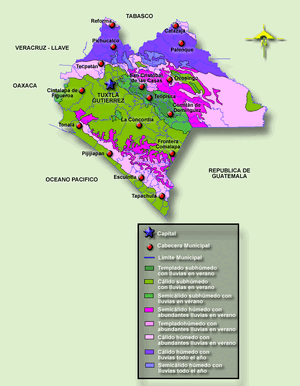
Source: http://mapserver.inegi.org.mx/geografia/espanol/estados/chis/climas.gif
- Indicates year-round rainfall in the humid jungles in the north of the state and abundant summer rainfall north and
east of San Cristobal.
Rainfall
The amount of rainfall in a region determines the seasonal water flow in a river. A more feasible location for siting a micro hydro system has a small annual range of flows (as opposed to an area with a wide range of slows between seasons).
- Map of Annual Precipitation for the State of Chiapas
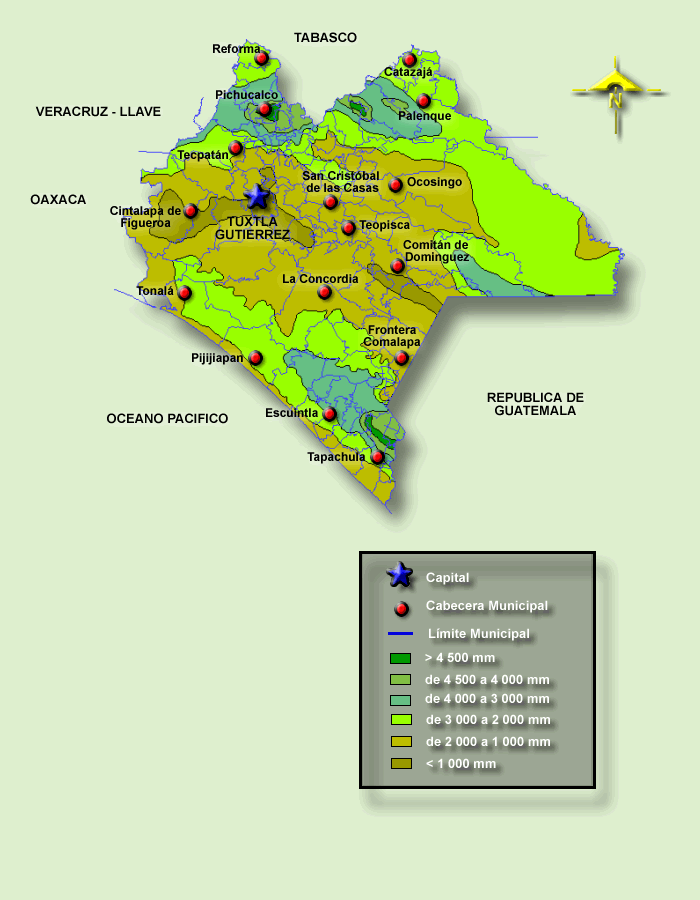
Source: http://mapserver.inegi.org.mx/geografia/espanol/estados/chis/precipit.cfm?c=444&e=07
- Table of Precipitation for States in Mexico
- Micro-Hydropower Systems: A Buyer's Guide by Natural Resources Canada.

- Section 2.1, page 9 of the book provides information on flow duration curves and how seasonal changes in flow will affect energy calculations.
Flooding
- http://es.wikipedia.org/wiki/Inundaci%C3%B3n_de_Tabasco_y_Chiapas_de_2007
- Description of October 2007 flood that occurred as a result of above-average rainfall from tropical storm Noel. The Grijalva River separates Chiapas from the neighboring state of Tabasco and has several dams which generate the majority of Mexico´s electricity. The Peñitas Dam was overwhelmed by the high river level from rains falling in Chiapas and began to flood the deforested Tabascan plains. This destroyed the Tabascan capital of Villahermosa, which is surrounded by rivers. It sits below river level and is protected by a system of canals and dikes. A landslide also occurred in Chiapas in the town of Juan de Grijalva, destroying 100 homes.
- This type of flooding caused by deforestation, faulty city planning and the construction of large-scale hydroelectric power also falls under the cultural considerations of micro hydro power in this region and illustrates an advantage of building small-scale hydroelectric power.
Cultural Considerations
- http://xojobil.blogspot.com/search/label/Mapas
- Zapatista blog containing maps of indigenous groups, armed groups and paramilitaries, and autonomous Zapatista communities
- Article regarding protest march held by the indigenous community of Huixtán in March 2009
- The community was protesting an increase in electricity taxes levied by the Federal Electricity Commission that they cannot afford. The community felt angered by the fact that although Chiapas remains one of the pooerst states, it also contributes a great portion of the country´s electricity and should have a right to its own electrical power. Many communities for this reason resist paying the federal government for power and instead have learned how to maintain their own repairs on power lines, so they did not feel obligated to pay this tax.
- Electrical Energy in Mexico and Chiapas: Rights, Resistances and Privatization
- Focuses on the unequal distribution of taxes affecting the poor who can least afford to pay them, the privatization of hydroelectric power, ecological problems resulting from the construction of dams in the Chiapas region that power the the city of México D.F., and the resistance of indigineous communities to paying electricity taxes and bills.
- An interesting fact of note: In Chiapas, 8% of the electricity users account for 50% of electricity use.
- November 2008 public denouncement of government tariff increases by Pueblos Unidos en Defensa de la Energia Eléctrica (PUDEE)
-
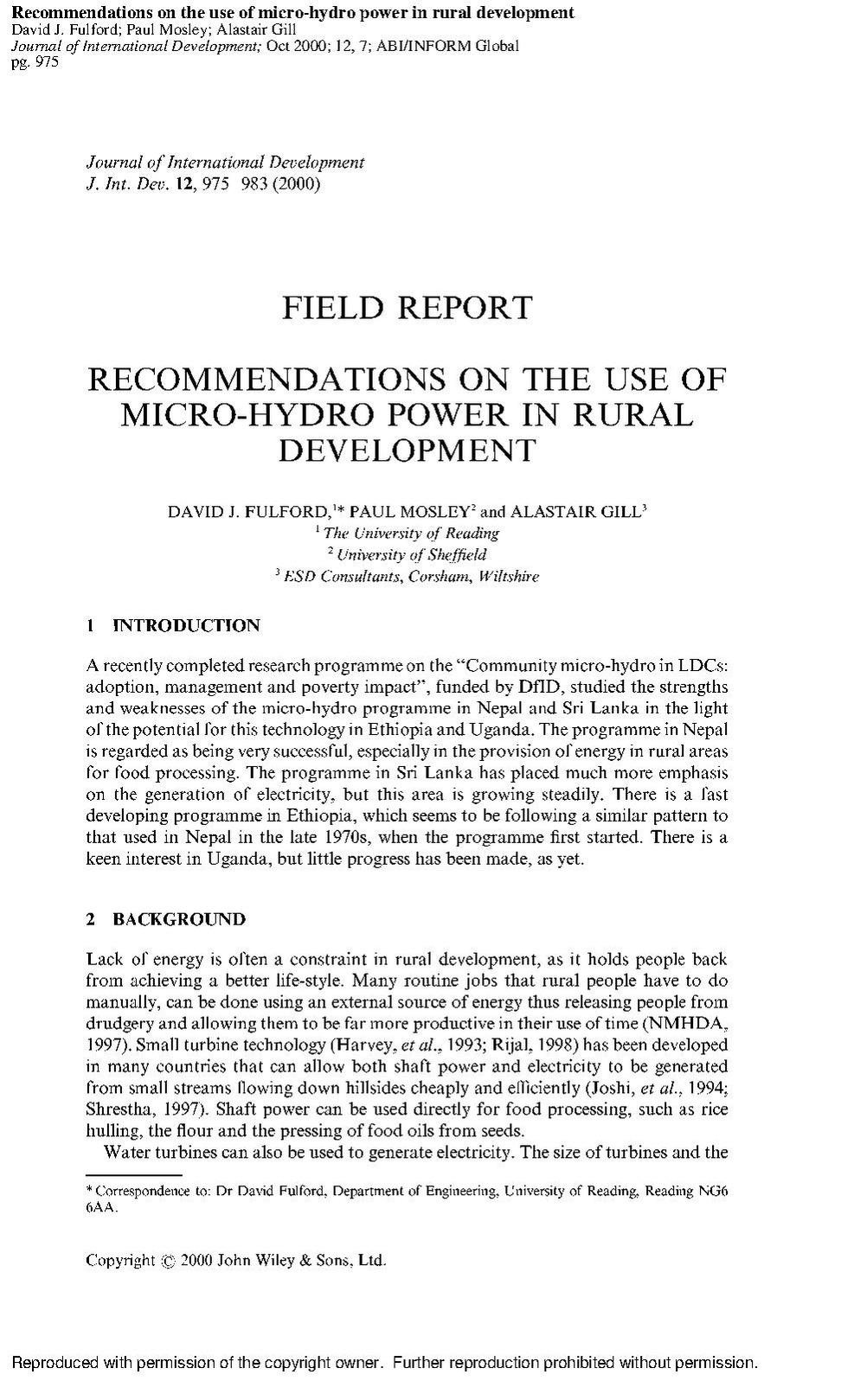
- Considerations for developing a successful micro hydro installment that promotes widespread use and has a meaningful and significant impact on rural electrification needs.
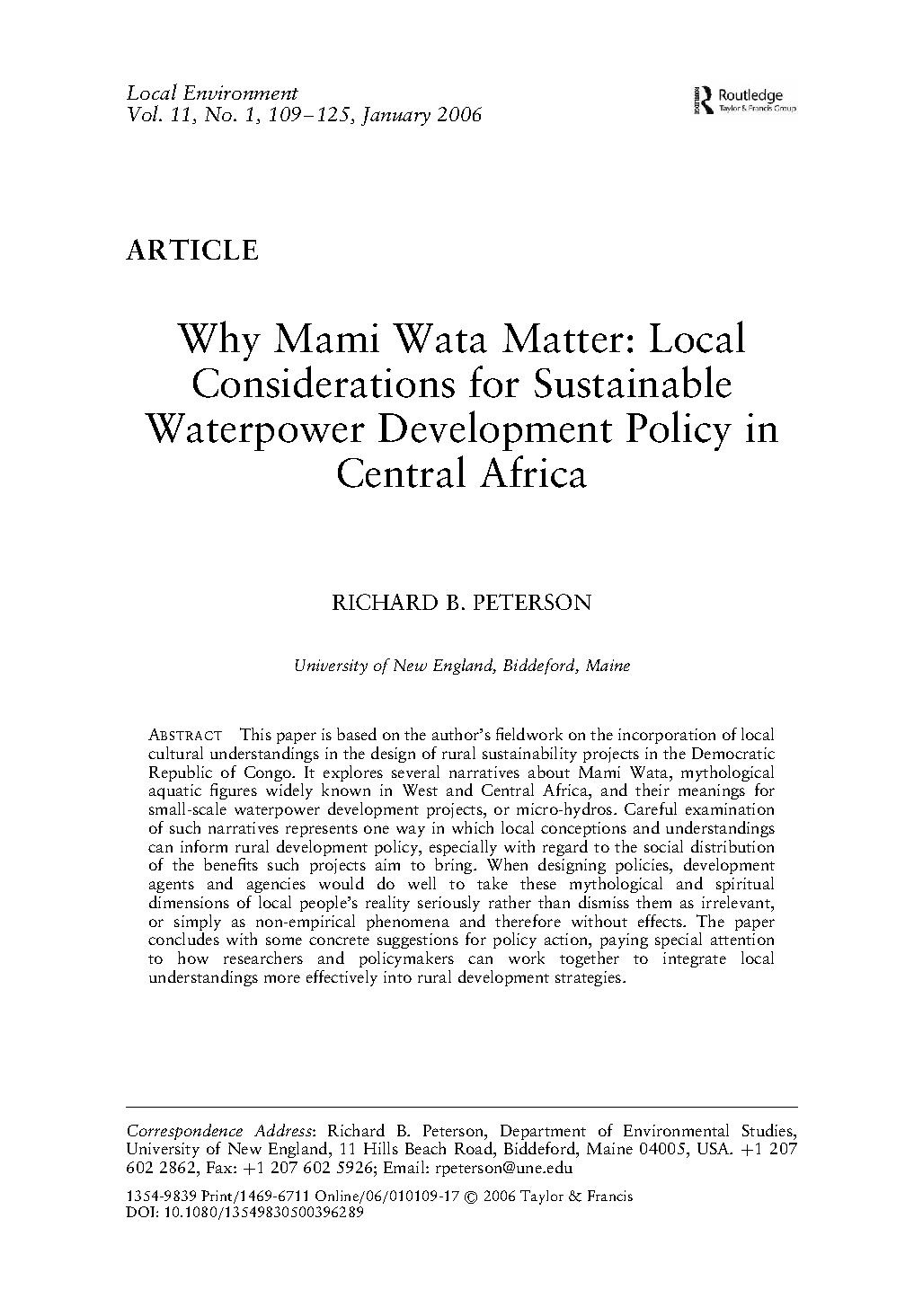
- Cultural considerations can extend beyond simply new technology introduced to an undeveloped area. This article from January 2006 provides insight into the problems that might be encountered when attempting to install a community driven Micro Hydro system in a rural area. Though this article is concerned with a different region of the world, it examines a culture with beliefs concerning nature that can be considered similar to some of the beliefs of some of the cultures that are found in Chiapas that stem from ancient Maya belief systems.
Criteria
Criteria
| Criteria | Description | Weight |
|---|---|---|
| Aesthetics | Doesn't impede cultural needs. | 6 |
| Community Involvement | Community has interest and need. | 5 |
| Cost Efficiency | Cost/kW, availability of local materials, and low maintenance. | 9.5 |
| Educational | System educates community about sustainable energy. | 6 |
| Environmental Effect | Diverts an appropriate amount of water and does not harm aquatic life. | 7 |
| Location of Site | Close to community with access to a continuously reliable water source. | 9.5 |
Sites
River Visited with Class
Date Visited:
Flow rate calculated:
Head:
Length of Pipe:
P max:
P net:
Feasibility:
Río de Alcanfores
Date Visited: 17 June 2010
Flow rate calculated:
Head: 15 feet
P max: 730 Watts
Feasibility: This river is close to the neighborhood of Alcanfores, outside of San Cristóbal, the amount of power generated by this stream during the rainy season is sufficient to consider the site feasible for the construction of a pico-hydro system. This stream is of interest, because the community of Alcanfores is near the site surveyed, and a Zapatista community seeking independence from the government lies approximately an hour further upstream.
Río Jataté en el pueblo de Corralito
Date Visited: 14 June 2010
Feasibility: This site lies a bit further from San Cristóbal on the way to Ocosingo and Palenque. Winding down out of the mountains a bit, we could see that the vegetation grew more lush and the maps indicated that heading in this direction would be an ideal zone in terms of rainfall, topographic variety and community location. Corralito is a tiny farming community known for its small touristic attraction of a waterfall in the headwaters of Río Jataté, which goes on to power the mighty cascades of Agua Azul. It was a river of approximately 5 or 8 meters in width, narrowing to 1 or 2 meters at points, with a strong flow and what looked to be substantial depth. We did not take measurements because of its width and depth and lack of both time and proper introduction to the community. We did speak with a local agronomist, who said that the large power lines we saw were from the government and we observed a buildboard near the center of the very small community reading that it was being supported by the PRI political party and the government was funding construction there. On the way back, Rachel was advised by a local combi driver to continue towards Ocosingo in search of small communities with power needs and river assets and given the names of a few such communities. We also passed many signs for other communities reading that they were in protest of paying high government taxes for electricity to power their lights, which may present other opportunities for investigation.
Río de Zinacantán
Date Visited:
Flow rate calculated:
Head:
Length of Pipe:
P max:
P net:
Feasibility:
Río de Las Canastas, San Cristóbal
Date Visited:
Flow rate calculated:
Head:
Length of Pipe:
P max:
P net:
Feasibility:
Río del Arcotete, San Cristóbal
Date Visited:
Flow rate calculated:
Head:
Length of Pipe:
P max:
P net:
Feasibility:
References
- ↑ Some high flow, low head situations can use hydropower systems such as a water wheel to convert just kinetic energy of the flowing water with very little change in the potential energy. In those cases, <math>P = \frac{1}{2}\,\rho\,\phi\, v^2</math> where <math>\, v</math> is the velocity of the water.








